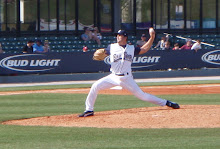
So far, we spoken specifically about what the pitcher, individually, can do to prevent runners from stealing bases. Approaches such as changing looks, timing, and pick offs are all part of the defenses at the pitcher's disposal to catch would-be base stealers.
In this installment, we will look at a couple scenarios that involve not just the pitcher, but the other fielders to help hold the runner on and prevent him from getting any kind of stealing jump. The first relationship to be discussed is between the catcher and the pitcher. Since the catcher has a better viewing angle on what the runners are doing, he can see, better than the pitcher, what the runner is doing. Regardless of whether the sign originates from the dugout (called by the coach) or solely from the catcher, the catcher can indicate to the pitcher that the runner is taking too many liberties on the base and he needs to pick over. Generally, there is a unique set of signs that indicate to the pitcher that a pick is on. For example, the "horns" series is created by putting the index and pinky fingers down as the first sign, followed by either a 1, 2 or 3. The second sign dictates where the pick should go with first base obviously corresponding to the number 1 and so on and so forth. It is important to note here that it is essential for the fielders to be reading the signs as well. If a short stop or second baseman sees a "horns 2" sign, this indicates a timing pick based on the number of looks is coming to second. This tells the short stop or second baseman to break to the bag as the pitcher looks back toward home (on the predetermined number of looks). After he looks, home, he will continue his rotation back around to start the pick off to second base. Also, from the horns series, the catcher can indicate other unique pieces of the running defense. A "horns - horns" sign can indicate a pitch out and a "horns - fist" can tell the pitcher to hold the ball until the hitter steps out of the box. Just make sure that the first sign is unique enough to tell the pitcher it is not a sign for a pitch.
Another relationship designed for the cessation of base stealers exists between the fielders and the pitcher. At any point in a game, in between pitches, a sign must exist that allows a fielder to indicate that THEY want the pitcher to pick to their bag. The sign itself, of course, can be any number of things as long as it is inconspicuous. A good example would be covering the emblem on the hat as if the fielder was adjusting his hat. The key here falls two-fold on the pitcher. First, he must disciplined enough to look at his fielders after every pitch when a runner is present. It doesn't have to a long look, but just enough for the fielder to cover his hat, for example, to indicate that he wants the pick. With a thousand other things to consider, it is easy sometimes to forget to look at all the fielders. Secondly, it is the pitchers responsibility to acknowledge that he has received the pick sign as well. This sign can be just simple as long as it is discreet. The adjusting of the cup could serve the needed purpose quite well. Generally, speaking, once the pick is put on by the fielder and acknowledged by the pitcher, it is cued off of the head looks of the pitcher. For example, if the first baseman gives the sign, then the pitcher (a righty) will come set, check the runner once, check him twice, and after looking home, spins and picks. For a lefty, the leg lift will cue the pick is coming. The key, of course, is communicate silently to the each other that the pick is coming.
The last relationship involves the middle infielders when there is a runner on second. Sometimes, an opportunity presents itself for the pick off after the pitcher comes set. If the runner extends its lead too far, for example, or seems to loose focus while off the bag, the infielder can indicate to the pitcher to essentially "PICK NOW!" The fielder does this with what is know as the "flash pick." In the case of the short stop, he will wait until the pitcher looks his way and then break to the bag with his glove hand extended to the bag. As soon as the pitcher sees this, he must immediately turn and spin pick, getting the throw to the bag at the same time the fielder gets to the bag. On the flip side, if the second baseman does the break to the bag, he shows an open throwing hand when the pitcher is looking and the picks is timed in similar fashion. This technique should be used sparingly because the element of surprise is the key to making this work. However, if timed correctly, the pitcher can quickly get himself out of a sticky situation.
So there we have it. I know this is a bit in depth and I, truthfully, I could do a post on each scenario. However, this should suffice for now. Let me know if you have any specific scenarios or questions.
Until NextTime!!!

No comments:
Post a Comment